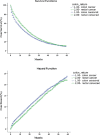Surveillance, Epidemiology, and End Results (SEER) and SEER-Medicare Databases: Use in Clinical Research for Improving Colorectal Cancer Outcomes
- PMID: 30647547
- PMCID: PMC6327727
- DOI: 10.1055/s-0038-1673355
Surveillance, Epidemiology, and End Results (SEER) and SEER-Medicare Databases: Use in Clinical Research for Improving Colorectal Cancer Outcomes
Abstract
The Surveillance, Epidemiology, and End Results (SEER) program is a clinical database, funded by the National Cancer Institute (NCI), which was created to collect cancer incidence, prevalence, and survival data from U.S. cancer registries. By capturing approximately 30% of the U.S. population, it serves as a powerful resource for researchers focused on understanding the natural history of colorectal cancer and improvement in patient care. The linked SEER-Medicare database is a robust database allowing investigators to perform studies focusing on health disparities, quality of care, and cost of treatment in oncologic disease. Since its infancy in the early 1970s, the database has been utilized for thousands of studies resulting in novel publications that have shaped our management of colorectal cancer among other malignancies.
Keywords: SEER; SEER-Medicare; colon cancer; outcomes research; rectal cancer.
Figures
References
-
- Cutler S J, Scotto J, Devesa S S, Connelly R R. Third National Cancer Survey--an overview of available information. J Natl Cancer Inst. 1974;53(06):1565–1575. - PubMed
-
- Hankey B F, Ries L A, Edwards B K. The surveillance, epidemiology, and end results program: a national resource. Cancer Epidemiol Biomarkers Prev. 1999;8(12):1117–1121. - PubMed
-
- Surveillance, Epidemiology, and End Results Program. Available at:http://seer.cancer.gov/registries/. Accessed May 10, 2016
-
- Yu J B, Gross C P, Wilson L D, Smith B D. NCI SEER public-use data: applications and limitations in oncology research. Oncology (Williston Park) 2009;23(03):288–295. - PubMed



